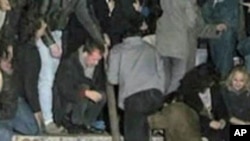For nearly three decades the Berlin Wall was the symbol of the Cold War - it divided a city and in effect the entire country. And then on November 9, 1989 it crumbled and with it Communist East Germany and the Cold War itself.
On the outskirts of Berlin lies the Glienicke Bridge. It spans the Havel River and connects Berlin to the neighboring city of Potsdam.
Its idyllic setting belies a darker history. During the height of the Cold War, it was known as the Bridge of Spies - where communist and western officials exchanged secret agents that had been found out.
Walking across the bridge now, Potsdam resident, Haio Koelling remembers the stories about the prisoner exchanges. "Yes, I think the exchanges took place right here," Koelling says, " The secret agent would be sent out from one military checkpoint to the other - in plain view of both sides. But for us civilians, as of 1961 the bridge didn't exist anymore. We couldn't get close. You could see it from over there, but the Wall blocked it."
The Wall ran along the shoreline. Construction began in August 1961 by the communist East German government as a physical barrier through heart of Berlin. But the Wall eventually encircled all of West Berlin - cutting it off from East Berlin and the rest of East Germany.
A longer boundary divided the entire country into East and West. It symbolized the Iron Curtain - the dividing line between the West and the East or Soviet bloc.
It was a source of tension and there were constant fears the Cold War might erupt into full blown conflict.
But, with the passage of time, cracks began forming in the communist system, says political analyst Jochen Staadt of Berlin's Free University. "There were some people who knew that the GDR, East Germany is in a bad situation, the economy was going down," he says, "As we now know our secret service they knew a lot about that."
A more obvious sign of change came in the mid 1980s when Mikhail Gorbachev - a reformer took power in Moscow. That, says Staadt, was crucial. "When Mr. Gorbachev came to power in the Soviet Union there were signs and one of the most important signs was that people in the Soviet Union started to talk publicly about reunion of Germany," Staadt said.
There was a difference of opinion between Moscow and East Berlin, and the Kremlin's support for East Germany's communist leadership was waning, says Staadt. And, it was a split, western leaders, like Ronald Reagan, tapped into. "Mr. Gorbachev, tear down this Wall," Mr. Reagan said.
Change was afoot as President Reagan uttered that now famous challenge in 1987. Reform movements gained ground within the Soviet bloc and by the summer of 1989 East Germans found a way to the West through Hungary and peaceful protests spread in East Germany.
While western pressure played a part as events unfolded, key was Mikhail Gorbachev, says political analyst Michael Cox of the London School of Economics. "I think once the Soviet Union, Moscow, Gorbachev and the Politburo have made that decision not to use force then the whole house of cards is bound to come crumbling down," Cox said.
And crumble it did, faster than anyone had anticipated - on November 9, 1989. The Berlin Wall fell and took with it the East German communist regime.
But what would happen next was no foregone conclusion, says Cox. Crucial negotiations would follow about the new structure of Europe and how Germany would fit in.
"Because don't forget in 1989 and 1990 when Germany unified many Europeans were worried and therefore it was extraordinarily important for very, very complicated diplomacy to engage Germany within Europe and as an Atlantic player," Mr. Cox explains, "Don't forget that Gorbachev in the end had to say yes. It was Gorbachev in the end who had to say we will not use force. In the sense I would say that in the end whilst looking for the key figure in all of this it was Mikhail Gorbachev."
Germany was reunited in 1990, the Soviet Union was dissolved by 1991, the Cold War had drawn to a close.
Back on the Glienicke Bridge, Haio Koelling talks about the changes in his life. Under the communist government he worked as an architect and city planner for Potsdam. After the Wall fell he started his own architectural firm. He's now retired, still lives in what was once East Germany. But he can walk across the Glienicke Bridge now at will - no barriers, no checkpoints, no walls.







